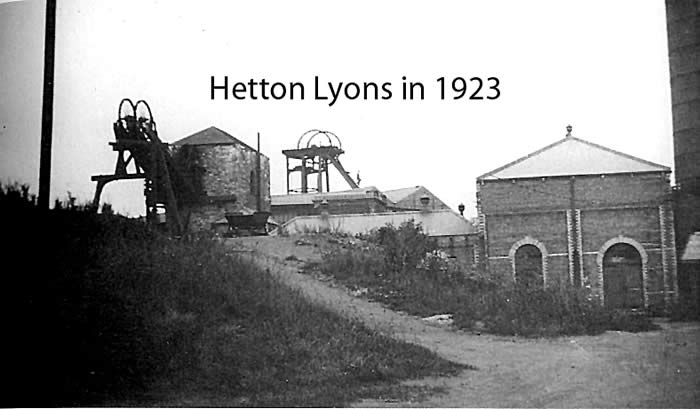
return to homepage
Hetton Local History Group - Boundary Heritage Walk Part 2
Point G information 
(GR 366 468 ) Directions to point H On gaining the lowest point of the dismantled railway a small bridge is crossed over a concrete spillway carrying water from a small pond on the left. Proceed up the hill for approximately 15 metres then turn left along a tarmac path adjacent to a high spiked metal fence. This leads into a car park for fishermen using the nearby fishing lake (Stephenson Lake). Continue through the car park then turn left at the junction and proceed to the next junction nearby with the B1285 road. Turn right towards Hetton down the B1285. Passing new houses on the left and a street of white cottages and then a green grassed football sized field. s the road next to the first bungalow and walk along a path on the perimiter of the field. On your left is the cricket ground for Hetton Lyons CC. Proceed until you arrive at the main A182 road next to the Lyons Tavern.. ( Point H) GR 357 467 QR code or link to information. Heritage Information Point G Over the fence next to the fishing lake was once the location of the Hetton Lyons Colliery. In 1820 the Hetton Coal Company, the first major Joint Stock Company in the North of England, was formed by Messrs Cockrane, Mountsay, Burrell, Stuart Mobray, Smithson, Embleton, Nicholas Wood and later by his sons Collingwood, Nicholas, John and Lindsay. The venture began at Hetton Lyons on the 19th of December, 1820, when Lady Cochrane cut the first sod and sinking operations commenced in February 1821. The successful winning of this colliery was the beginning of a new era in the history of mining. Following it, mining in the area of Hetton developed rapidly. By 1825 both Elemore and Eppleton pits were in the process of being won.Conditions in the mines were harsh in these early days. When Hetton Colliery was opened in 1822 the temperature at the bottom of the shaft was 66 degrees and 70 degrees in the workings. The shaft was 15 feet in diameter and a pumping engine was necessary to extract water. It was of 300HP, and was powered by 4 large boilers. There were two winding engines each of 9Ohp and each was supplied by two boilers. Two extra boilers were kept going in case of a break down, The rope for drawing the coals was made of hemp and stranded wire. It was 220 fathoms in length, weighed two tons and cost over £100, a very large sum of money in those days. Two very serious explosions occurred in the Hetton Mines due to the presence of fire-damp, On January 29th, 1836, twenty two men and boys of Eppleton Colliery died and on December 20th 1860, by strange and terrible coincidence the same number lost their lives at Hetton Lyons. In the year 1821 upon the successful winning of the new mine, the proprietors of the Hetton Coal Company were faced with the problem of transporting the coal across the country-side to the staithes on the Wear for shipment to the markets of the South. Nicholas Wood, one of the proprietors, who was born near Wylam in 1795, had became a close friend of George Stephenson in 1818. Following this he assisted Stephenson in his experiments at Killingworth. Although Wood himself was an inventor and later became known as an eminent engineer, his contribution to railway development at this time lay in his encouragement of Stephenson. The newly formed Hetton Coal Company invited Wood to take control of their mines and it was largely due to his influence that the Company succeeded. Under his recommendation the Company invited Stephenson to take charge of laying a line from the mine to the staithes in Sunderland, approximately 8 miles away, to be worked by locomotives. Thus Wood contributed to the eventual establishment of public railways by his endorsement of this pioneering project. Stephenson surveyed the route and decided that, due to the undulating nature of the countryside, some of the gradients would be too steep for his locomotives which were not then powerful enough to haul a heavy load up a steep incline. He therefore planned to use the locomotives where the gradients were less than one in 500. Where the gradient was more than 1 in 30 he proposed to use stationary engines. The line was therefore to consist of: The laying of the line was supervised by Robert Stephenson, brother to George, who became resident engineer at Hetton Colliery. The line took three years to build, while George went off in 1821 to plan and build the Stockton to Darlington Railway. The Hetton Colliery Railway was, on its opening in 1822, the very first in the world that had been built to be operated by steam locomotives, which thus gives Hetton a very important role in world railway history. George Stephenson himself said that its opening was the most thrilling event of his life, and he could not sleep for excitement. The first train was a locomotive hauling 17 trucks, the weight of coal being 64 tons. The average speed was 4mph. a remarkable speed at this time for such a heavily loaded train. The following account of the opening is taken from the edition of the “Durham Chronical" dated 18th November, 1822:
|
-- info@hettonlocalhistory.org.uk --


